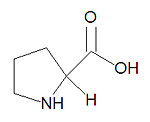General Features:
Abbreviated: Pro or P
Molecular formula: C5H9NO2
pKa: 2.351

Zwitterionic structure of both proline enantiomers:
(S)-proline and (R)-proline
Physiological Roles:
Due to the cyclic structure of proline’s side chains, the
amino acid is exceptionally rigid in its conformation when compared to other
amino acids. It loses less conformational entropy when exposed to higher
temperatures and thus is more prevalent in thermophilic organisms. For example,
the secondary alcohol dehydrogenase from Thermoanaerobium brockii contains
eight more prolines than its mesophilic homologue from Clostridium beijerinckii
(Li et al, 1999).
Further, due to its side chain constraints and steric
hindrance, proline is a structural disrupter of alpha helices. Methylene
replaces what would normally be a hydrogen-bonding amide, and so the helix is
disrupted. Polyproline helices, however, may be formed when multiple prolines
are bound in sequence. This is a major component of collagen.
Takagi illustrates the final important roles of proline in biological systems in the article Proline as a stress protectant in yeast. In bacterial as well as plant cells, proline accumulates as an osmoprotectant in response to osmotic stress. In vitro, proline may also be employed to stabilize proteins and membranes, lower the T(m) of DNA, and scavenge reactive oxygen species. Because proline is an osmoprotectant, it is often used in pharmaceutical and biotech applications.
Biosynthesis and metabolism:
Proline is not considered an essential amino acid, because
it can be synthesized by the human body.
The mechanism of proline biosynthesis is a universal pathway
found in both prokaryotes and eukaryotes, although the mechanism of synthesis
of its precursor (L-glutamate) may vary between organisms. Although the image
shown below is for that of bacteria, it is essentially the same as in
eukaryotes. The location of the pathway differs between bacterial and human
cells, however.

Proline synthesis begins with the conversion of L-glutamate
to an acyl phosphate through a reaction with ATP via a kinase. The acyl
phosphate (L-glutamly-gamma-phosphate) is then reduced to
glutamic-gamma-semialdehyde by an NADPH-dependent reaction. The semialdehyde
may be subsequently converted to an ornithine, which is a precursor of either
proline or arginine depending on the final reaction. If the ornithine cyclizes
to form P5C, this can be reduced by NADPH to form proline.
The figure below illustrates proline catabolism and degredation to glutamate:

According to Singh et al., proline utilization proteins (PutAs) are bifunctional enzymes that catalyze the oxidation of proline to glutamate. PutAs contain secondary structural elements and domains not found in related monofunctional enzymes, thus confirming their bifunctionality.
Additional resources:
Click here for a more in-depth look at proline biosynthesis. Or if you'd rather spend your time appreciating proline metabolism, visit KEGG. You can even appreciate arginine metabolism while you're at it!
An indirect role of proline in the microbial world is its involvement in thymus development. Proline-rich polypeptides (PRP) can induce TH2 to TH1 shift. If this doesn't get you pumped, I don't know what does. Visit this website for more information on PRPs in the immune system!

No comments:
Post a Comment